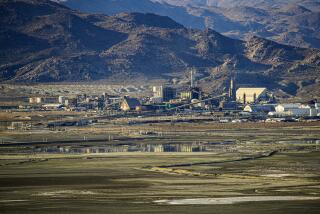Where recessionâs effects are magnified
TRACY, CALIF. â Sixty miles northeast of the sleek corporate campuses of Google Inc. and Intel Corp., housing tracts sit vacant. Factories are closed and job centers are packed with people looking for work.
Think Southern Californiaâs Inland Empire is suffering? By some measures, the inland region east of San Francisco has it just as bad.
Like Riverside and San Bernardino counties, the inland area that includes San Joaquin, Alameda and Contra Costa counties became bedroom communities for workers priced out of real estate markets closer to the coast. And just like the Inland Empire, the area was among the hardest hit by the economic downturn as buyers lost homes to foreclosure and prices plummeted.
But other factors have compounded the northern inland regionâs misery.
The financial crisis erased thousands of the areaâs banking and financial services jobs. The housing slowdown crippled dozens of manufacturers that made building supplies there. And the closure in April of Californiaâs only auto plant, in Fremont, snowballed into the shutdown of dozens of inland suppliers and the disappearance of tens of thousands of jobs.
Though some economists have predicted the technology-rich Bay Area would lead the state out of the downturn, Jeff Michael, an economist with the University of the Pacific at Stockton, says its inland areas will be among the last to recover.
âThat region has been really hard hit,â Michael said. âIt will be very slow to emerge from the recession.â
To be sure, parts of Contra Costa and Alameda counties are tied to the wealth of the Bay Area and will be helped by renewed growth in the tech sector. In San Ramon, home to Chevron Corp., the unemployment rate is just 4.7%, and in Fremont, which has an unemployment rate of 8.4%, a solar company just announced a $45-million investment. But farther inland, their eastern regions are still struggling, as is most of ailing San Joaquin County.
Housing is perhaps the biggest millstone. During the real estate boom, families that couldnât afford real estate in San Francisco headed inland, buying homes in towns such as Tracy, Manteca and Brentwood. Dwellings there could cost $500,000 less than comparable properties in the Bay Area, said Michael Locke, president and chief executive of the San Joaquin Partnership, a private economic development company. Builders rushed to put up homes in vast developments, and employment in financial services in the three counties grew by a third in just a few years.
Now, building has all but stopped. Home prices in San Joaquin County have fallen 63% since the peak median price of $451,500 in November 2005, according to MDA DataQuick. Prices in Contra Costa County are down 53% from their peak of $600,000 in April 2007. One in every 135 houses in Contra Costa County received a foreclosure filing in June 2010. In San Joaquin County, that figure is 1 in 104 -- nearly double the California average.
Signs of a slowdown are everywhere. At Bethel Island, a Contra Costa County summer vacation area normally busy with tourists and fishermen, boats sit rotting in the Sacramento River. Nearby, a planned residential waterfront development has stalled. The builder completed boat docks before pulling out, an eerie remnant of the luxury once planned there. In Livermore, an Alameda County town, whole shopping developments are empty and foreclosure notices dot homes.
In Stockton, which had one of the highest foreclosure rates in the nation, the median home price of $100,500 is down from $397,000 at the height of the boom -- a stunning 75% drop.
Thatâs forced people such as Troy White out of work. The onetime real estate agent has been looking for a job since 2007, the year he lost his home to foreclosure. His wife, a bus driver, commutes an hour and a half to Oakland to provide the only income for their family of four.
âPeople say this is the most miserable place in the world,â said White, standing in the hot sun outside a job center in downtown Stockton. âItâs really bad out here. There ainât no jobs.â
Weston Ranch, the Stockton community where White lost his home, was one of the epicenters of the California housing crash. Median home prices there dropped to $110,000 from $446,000 in a span of three years. Now foreclosures plague nearly every block. In April 2008, there were 1,003 notices of default served in the city, up two-thirds from a year earlier, according to ForeclosureRadar.com.
As in Southern Californiaâs Inland Empire, investors have taken over some of these properties, changing the texture of the neighborhood.
Standing on the front lawn of his Weston Ranch house, where rosebushes climb up trellises, resident Ruben Modesto showed a visitor the homes that had been foreclosed on in the last few years.
âOne, two, three, four, five, the one on the corner makes six, seven, eight nine, 10,â he said, pointing up and down the block. Across the street, a gaggle of children sat on a shopping cart. Modesto said renters, including low-income families with federal housing assistance, have moved into the neighborhood.
Heâs not sure whether he and his wife will be able to stay in their home. She recently lost her job, and their financial advisors have told them to walk away. They paid $450,000 for the house. Itâs now worth about $120,000.
But buyers are scarce. Homes much closer to employment centers such as San Francisco and San Jose have fallen to the prices Stockton enjoyed a few years ago.
âItâs not a bargain if you donât have a job,â Stockton real estate broker Rudy Willey said.
The unemployment rate in Stockton, the county seat of San Joaquin County, is 19.8%. Itâs 29% in the nearby hamlet of Garden Acres, higher than any city of its size in Southern Californiaâs Inland Empire. Closer to San Francisco, in the Contra Costa County city of Pittsburg, the unemployment rate is 18%. Some of the jobs have been lost because of closures in the manufacturing and financial services industries, traditionally strong in this area. And as the regionâs population cuts back on spending, stores and restaurants are also suffering.
But perhaps the biggest blow was the auto-plant shutdown. New United Motor Manufacturing Inc. -- known as NUMMI -- was a joint venture of General Motors Co. and Toyota Motor Corp. that employed about 4,700. By some estimates, its closure could cost the region as many as 40,000 jobs. Many inland suppliers have announced they are closing or laying off most of their workers, including Johnson Controls in Livermore, Pacific Coast Industries in Tracy and Kyoho Manufacturing California in Stockton.
âThe closure of NUMMI has reduced employment in a critical sector, not just in this county, but throughout Northern California,â said Bruce Kern, executive director of the East Bay Economic Development Assn. âThis has created a double whammy -- a reduction in the value of real estate and the loss of a critical sector providing pay.â
Larry Graves lost his job after GM and Toyota pulled out of the Fremont factory they had operated since the mid-1980s. One day last month, the 52-year-old was waiting to be interviewed at a job fair at a WorkNet center in Tracy.
âItâs a little scary,â he said, looking at the dozens of other people scattered around the room, each waiting nervously for a chance to be interviewed for a position as a forklift operator, administrative assistant or material handler. âThereâs so many people out there.â
Sitting next to him, Jane King took deep breaths to stay calm. She lost her job at a cookie company in Pleasanton in November 2008 and still hasnât found work. Her husband, a machinist, is also unemployed. They moved to Manteca, just north of Tracy, to buy a home in 2000, only to watch it plummet in value.
They now owe more than itâs worth. Kingâs unemployment benefits ran out in July, and the couple and their 3-year-old daughter have no health insurance.
âI think there are a lot of people in the same boat,â she said, clutching the job application.
With sales and property taxes plummeting, cash-strapped cities are hustling to attract businesses.
Like many areas, San Joaquin County has an enterprise zone. Businesses that locate there are eligible for tax breaks. Last year the county expanded its zone to 656 square miles.
Stockton attracted a power plant and a prison hospital, businesses other communities might not welcome. Gus Duran, the cityâs interim economic development director, said heâs trying to woo other businesses by slashing permit and development fees 50%.
And Tracyâs City Council has voted to develop an incentive plan to attract retailers to the half-empty West Valley Mall, where a Mervyns closure prompted other retailers to flee. On a recent afternoon, in the darkened side of the mall that once held the Mervyns, two teenagers groped each other on a bench near the empty stores.
Economists say the employment picture wonât likely get much better until things improve in the East Bay, which supported many inland jobs. The Port of Oakland has shed jobs as cargo traffic fell; import volumes tumbled 14% between the first quarter of 2007 and the same period in 2010, according to the National Retail Federation.
The region was also hit by the bankruptcy of Mervynâs, headquartered in Hayward, and the buyout of Longs Drug Stores Corp., based in Walnut Creek.
âStores donât last here,â said Edna Jones, a teacher sitting outside a closed Mervyns in Newark. âYou think somethingâs open, but itâs gone.â
A few blocks away, Mullesa Self pushed her baby across a parking lot outside a boarded-up Dollar Tree store at Mowry Crossing, a recently stalled development. She said sheâs been living in a nearby Motel 6 as she looks for work as a cashier. She passes the blighted development every day.
âLately, Iâve been noticing things going downhill,â she said. âBig-time.â
--
More to Read
Inside the business of entertainment
The Wide Shot brings you news, analysis and insights on everything from streaming wars to production â and what it all means for the future.
You may occasionally receive promotional content from the Los Angeles Times.











